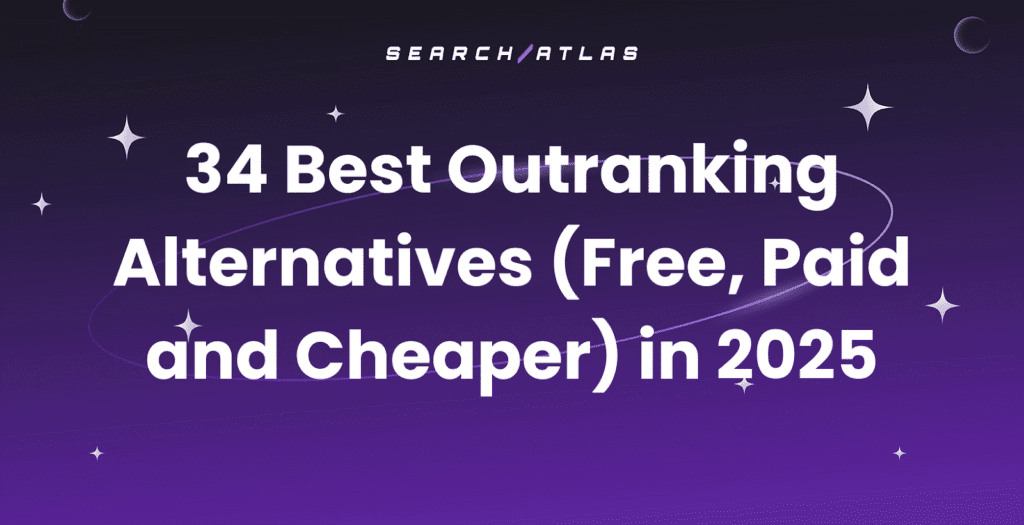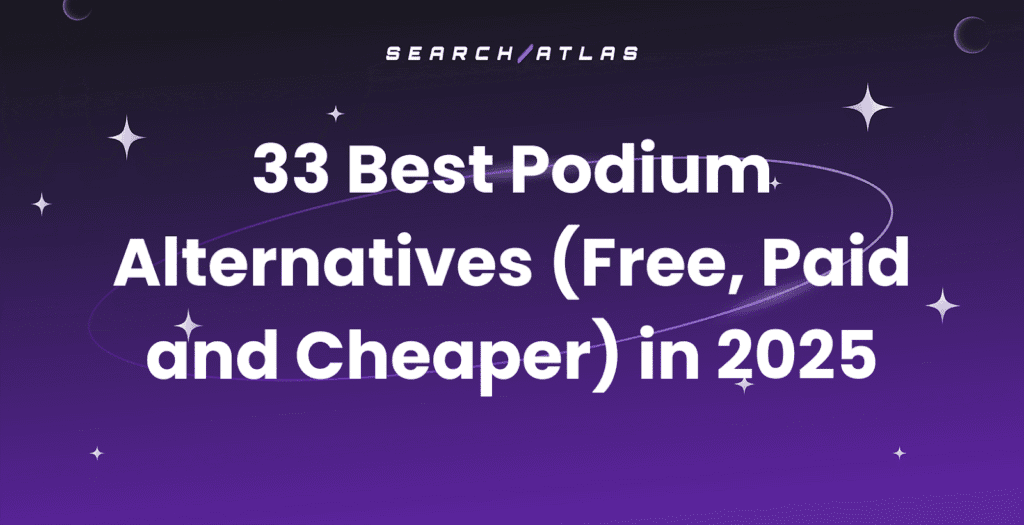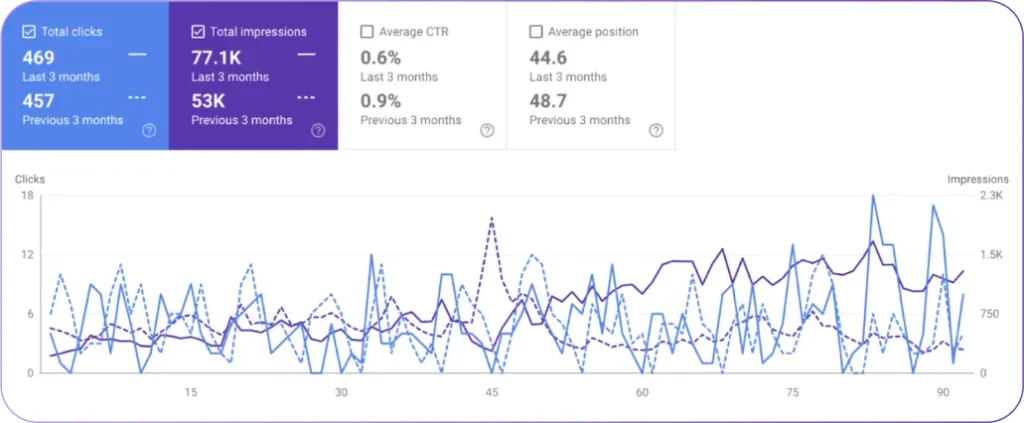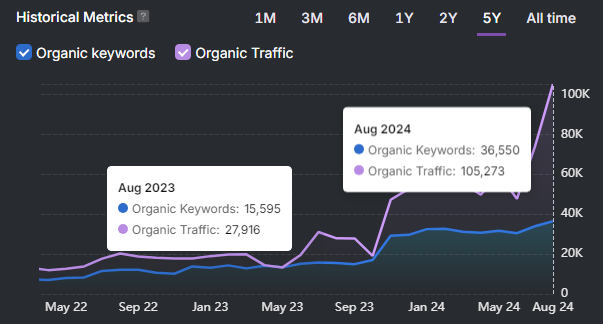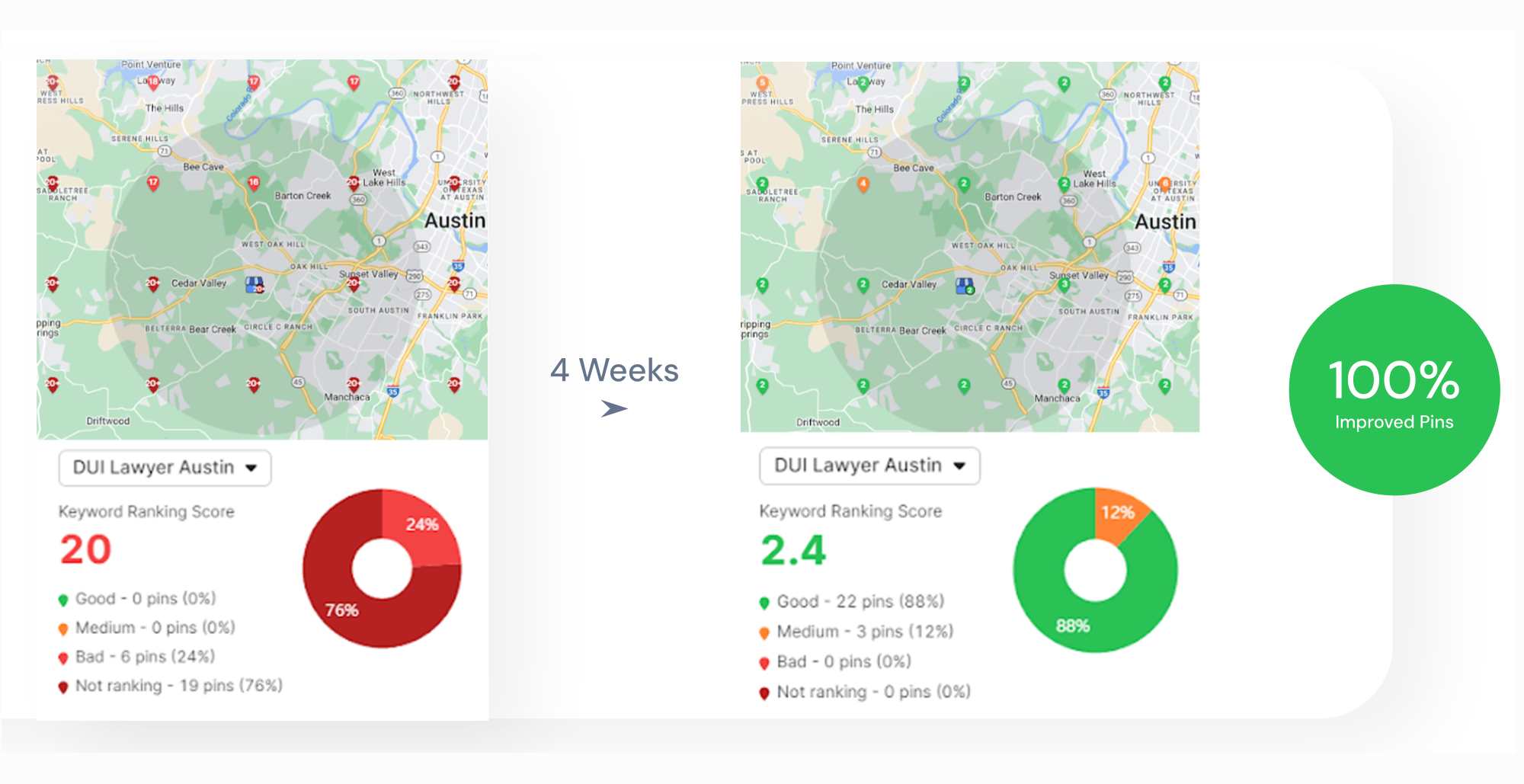The Ahrefs vs. Semrush comparison shows how each tool approaches core SEO workflows differently. The main features compared in Ahrefs vs. Semrush includes site audit, keyword research, backlink analysis, rank tracking, content optimization, and customer support.
Ahrefs pricing ranges from $29 to $1,499 per month across 5 plans. Semrush pricing ranges from $139.95 to $499.95 per month across 3 main tiers. Extra fees and add-ons reduce overall value for both tools. Budget-focused alternatives deliver similar features at lower costs.
Semrush and Ahrefs offer reliable features but Search Atlas stands out as the better overall option. It unifies content creation, technical SEO, authority building, local SEO and competitor analysis. Powered by OTTO SEO, its AI assistant delivers automation, speed, and scalability workflows beyond rival offerings.
What is Ahrefs?
Ahrefs is an SEO software that improves organic search visibility through backlink analysis, keyword research, rank tracking, and site auditing. Ahrefs operates its own crawler, AhrefsBot, and maintains a large backlink database.
Ahrefs includes keyword insights and content discovery for multiple countries, but these features deliver less depth compared to specialized tools. The Ahrefs SEO platform remains focused on core SEO capabilities rather than expanding into broader marketing functions.
What is Semrush?
Semrush is a digital marketing platform that provides tools for SEO, paid advertising, content creation, social media marketing, and competitive analysis. Semrush delivers keyword research, site audits, backlink analysis, and traffic metrics to support performance analysis and strategy adjustments.
Semrush includes domain comparisons, brand mention monitoring, and content planning, but its pricing is high for freelancers and small businesses. The Semrush platform focuses on multi-channel marketing functions and regularly updates its global datasets to deliver insights for both international and local markets.
How does Ahrefs Work?
Ahrefs continuously crawls the web to gather data on websites, pages, and backlinks. Its proprietary crawler scans billions of pages and compiles the information into an internal index. This index powers tools that provide insights into SEO performance, competitive analysis, and technical website health.
The platform organizes this data within tools such as Site Explorer, Keywords Explorer, and Site Audit. These tools evaluate backlink profiles, keyword rankings, and crawl issues. Ahrefs bases its insights on its own crawl scope and estimation models, which update slower than real-time changes or omit trends in smaller or regional markets.
How does Semrush Work?
Semrush gathers data from search engines, websites, and third-party sources, compiling it into an internal database. The platform uses proprietary crawlers to track changes in SERPs, keyword trends, backlinks, and site health.
Semrush data fuels tools that analyze domain visibility, keyword rankings, traffic estimates, and competitive positioning. Semrush builds its insights on collected data and estimation models, which differ from actual performance.
Ahrefs vs. Semrush: Which SEO Tool Is Better for Site Audit?
Semrush is better for site audits because it offers broader and more detailed technical SEO analysis. Its crawler simulates Googlebot behavior, which enables it to detect issues such as crawl errors, Core Web Vitals, HTTPS setup, and duplicate content.
Semrush includes advanced features like log file analysis and integrates with Google Analytics (GA4) and Google Search Console (GSC) for deeper insights. For users needing thorough site audits, Semrush provides more actionable data and robust reporting than Ahrefs.
What is the Key Difference between Semrush and Ahrefs?
The key difference between Semrush and Ahrefs in site audit features lies in their approach to issue detection, reporting, and automation.
Semrush offers a broad technical SEO overview, detecting many issues, which include minor warnings. It delivers detailed, customizable reports but requires users to prioritize fixes manually. Ahrefs focuses on prioritizing over 170 key issues by severity and type. It supports JavaScript rendering, and provides internal linking suggestions, though it offers fewer deep diagnostics.
Semrush fits teams needing comprehensive audits and detailed insights. Ahrefs suits users who want streamlined, priority-driven audits with modern web support.
Why is Crawling Technology so different on Ahrefs Compared to Semrush?
Ahrefs and Semrush use different crawling technologies that shape their site audit capabilities.
Ahrefs prioritizes a backlink-first crawling approach, focusing on discovering and analyzing links across the web. This results in exceptional link data but limits the crawler ability to capture the full range of on-page technical SEO issues.
The Semrush crawler, is designed to closely mimic Googlebot behavior, scanning and indexing pages more like Google does. This allows Semrush to collect broader technical and on-page data, which includes crawlability, page performance, and content optimization factors.
Why is Health Score so different on Semrush Compared to Ahrefs?
Ahrefs and Semrush calculate health scores using different methods.
Ahrefs bases its health score primarily on the percentage of internal URLs free from errors, emphasizing the cleanliness of website internal linking and basic technical issues. Semrush takes a more holistic approach by factoring Core Web Vitals, detailed technical issue severity, and overall site performance metrics.
The broader analysis of Semrush provides a more comprehensive view of website health, while Ahrefs offers a focused measure centered on internal URL integrity.
Ahrefs vs. Semrush: Which SEO Tool Is Better for Keyword Research?
Semrush excels in keyword research with larger databases, detailed filters, and advanced intent analysis. Its expansive keyword set and advanced segmentation suit users who prioritize large-scale keyword discovery and precise intent mapping.
Semrush fuller view of keyword potential drives measurable results, which make it more effective than Ahrefs for data-driven strategies targeting both volume and conversions.
What is the Key Difference between Semrush and Ahrefs?
The main difference between Semrush and Ahrefs in keyword research is that Semrush focuses on broader keyword discovery and intent-based segmentation, while Ahrefs emphasizes keyword metrics enriched by backlink and traffic potential data.
Semrush excels in broad keyword discovery by grouping terms by topic and search intent, using filters and CPC data to target long-tail keywords and plan SEO and PPC campaigns precisely. Ahrefs prioritizes keyword difficulty and traffic potential based on backlink profiles, offering a backlink-driven view that supports competitive insights rather than keyword discovery.
Why is Search Volume so different on Ahrefs Compared to Semrush?
Search volume differs between Ahrefs and Semrush because each platform uses unique data sources, collection methods, and estimation models. Its differences in input data and processing explain why the same keyword displays different search volumes across both platforms.
Ahrefs relies mainly on clickstream data, which tracks real user behavior to estimate both search volume and click potential. Semrush combines Google Keyword Planner data, third-party sources, and large-scale SERP scraping to create broader keyword databases and segment results by intent.
Why is Keyword Difficulty Calculation so different on Semrush Compared to Ahrefs?
Keyword difficulty (KD) calculation is different on Semrush compared to Ahrefs because each platform uses a unique scoring method and factor weighting.
Ahrefs calculates KD mainly from the number of referring domains to the top 10 ranking pages. It counts backlinks to these pages, with more links indicating higher difficulty. Semrush uses a broader formula that combines multiple ranking signals, which includes referring domains, dofollow/nofollow ratios, domain authority scores, and SERP-specific features.
This difference means Ahrefs provides a backlink-focused difficulty score, while Semrush gives a multi-factor difficulty score influenced by both link profiles and keyword-specific search characteristics.
Ahrefs vs. Semrush: Which SEO Tool Is Better for Backlink Analysis?
Ahrefs is better for backlink analysis with deep data and fast updates. It allows users to analyze domain strength, track new and lost links, and identify which content attracts backlinks.
The Ahrefs large and fresh link index makes it the most reliable tool for detailed link tracking, competitive analysis, and identifying high-impact backlink strategies than Semrush.
What is the Key Difference between Semrush and Ahrefs?
The key difference between Semrush and Ahrefs in backlink analysis lies in database size, update frequency, and context depth.
Ahrefs maintains one of the largest and fastest live backlink indexes with a reliable tracking of new and lost links in near real time. It refreshes referring domains, link growth trends, and anchor text distribution with deep historical context, which allows precise identification of link gains or losses.
Semrush segments link types, detects toxic links, and identifies competitor link gaps to guide outreach planning. Semrish provides a smaller backlink index, and its slower updates some backlink placements that Ahrefs captures.
Why is Link Quality Evaluation so different on Ahrefs Compared to Semrush?
Link quality evaluation is different on Ahrefs compared to Semrush because Ahrefs focuses exclusively on backlink equity while Semrush uses a blended scoring model.
Ahrefs scores sites using domain rating and URL rating, based on backlink quantity and quality. A site scores high even without organic traffic if it has strong inbound links. Ahrefs values in-content links more than sidebar or footer links and does not consider traffic or engagement.
Semrush calculates Authority Score by combining backlink data with estimated organic traffic and spam signals. Semrush factors in link context, topical relevance, and follow or nofollow status when assessing backlink quality.
Why is Link Historical Depth so different on Semrush Compared to Ahrefs?
Link historical depth differs between Ahrefs and Semrush because Ahrefs stores all backlinks ever found, while Semrush focuses on recent data.
Semrush emphasizes a Fresh Index, tracking backlinks from about the last 6 months. This makes it better for monitoring new campaigns and current backlink activity. Ahrefs keeps a Historical Index with every backlink detected, even those removed later. This enables tracking link growth, lost links, and long-term SEO trends.
Ahrefs vs. Semrush: Which SEO Tool Is Better for Content Optimization?
Semrush is better for content optimization because its toolkit covers the entire workflow from ideation to publishing. The Semrush platform integrates directly with Google Docs and WordPress, which enable in-platform editing and seamless publishing.
Ahrefs lacks an integrated writing and optimization suite, while the Semrush broader content features make it the more complete choice for teams aiming to produce, refine, and deploy high-ranking content efficiently.
What is the Key Difference between Semrush and Ahrefs?
The key difference in content optimization between Semrush and Ahrefs lies in their approach and timing. Semrush offers real-time guidance for active content creation, while Ahrefs focuses on performance analysis and gap identification using historical and competitive data.
Semrush offers a full content optimization suite with Topic Research to uncover popular ideas, SEO Content Template to generate SEO briefs, and the SEO Writing Assistant to suggest related terms and flag errors, which helps align content with search intent and brand style during writing. Some suggestions require manual adjustment for natural flow.
The Ahrefs Content Explorer analyzes top pages for backlinks, traffic, and shares. Its AI Content Helper compares your content to competitors, identifies key topics, and spots gaps to improve rankings. While providing strong data-driven insight, it lacks real-time editing feedback
Why is real-time content scoring so different on Ahrefs compared to Semrush?
Real-time content scoring differs between Ahrefs and Semrush because their systems measure different elements and aim for different optimization goals.
Ahrefs evaluates topical coverage by comparing your draft to top-ranking pages. It scores how well your content covers relevant subtopics. The score updates instantly with edits and focuses on content completeness rather than style.
Semrush uses multiple factors such as keyword placement, tone, and originality. It provides a dynamic, composite score with detailed guidance on specific issues as you write. This broader scoring supports holistic optimization but makes scores less comparable to top-ranking pages.
Why is content gap identification so different on Ahrefs compared to Semrush?
Content gap identification is different on Ahrefs compared to Semrush because each platform uses a distinct comparison method and data presentation style.
The Ahrefs Content Gap tool performs ranking-based domain comparisons. It identifies keywords competitors rank for but your site lacks and enables side-by-side analysis of multiple domains. This approach builds topical authority and highlights c
lusters of missing keywords within a niche.
The Semrush Keyword Gap tool uses a visual, page-specific format. It displays missing keywords and links them directly to competitor pages ranking for them. The platform integrates paid keyword data and offers flexible exports, supporting users who combine SEO and PPC research.
Ahrefs focuses on uncovering broader keyword opportunities through domain-level analysis, while Semrush delivers a more granular, page-by-page view with richer PPC and reporting capabilities
Ahrefs vs. Semrush: Which SEO Tool Is Better for Ranking Tracking?
Semrush is better for rank tracking because it delivers more frequent updates, wider search engine coverage, and detailed local and mobile results. It monitors daily keyword movements across multiple devices and regions, helping marketers react quickly to ranking changes.
Additional metrics such as SERP feature tracking and visibility scores offer a fuller picture of search performance. This depth of reporting makes Semrush more effective for campaigns that require granular monitoring and adaptability in competitive SEO environments than Ahrefs.
What is the Key Difference between Semrush and Ahrefs?
The key difference between Semrush and Ahrefs in rank tracking is that Semrush offers broader tracking across search engines, devices, and local areas, while Ahrefs focuses on Google-only data with simpler customization and deeper historical insights.
Semrush offers broad flexibility, monitoring rankings on Google, Bing, Baidu, and ChatGPT. It tracks desktop and mobile results at precise locations daily, which includes SERP features and competitor moves. This suits multi-platform, local, and mobile-first campaigns requiring detailed visibility and swift response.
Ahrefs focuses on Google rankings across 190+ countries with strong historical data. It’s better suited for long-term progress tracking and high-level competitive comparisons, providing clear visual trends, share of voice metrics, and SERP feature presence.
Why is the way ranking history is displayed so different on Ahrefs compared to Semrush?
The difference in how ranking history is displayed on Ahrefs compared to Semrush comes down to data update frequency, visualization style, and tool design priorities.
Semrush updates ranking data more often, even for lower-tier plans, which creates a more continuous and detailed history line. It layers in extra context through features like its Visibility score, which combines rankings and estimated traffic into a single trend metric.
Ahrefs updates ranking history less often on lower plans, showing fewer data points. It highlights direct position changes per keyword without combining scores. Its visuals focus on clear, precise keyword trends and SERP comparisons instead of aggregated metrics.
Why is share of voice calculation so different on Semrush Compared to Ahrefs?
Share of voice (SOV) is calculated differently on Semrush compared to Ahrefs because each platform uses distinct definitions, keyword sets, and traffic estimation models.
Ahrefs calculates share of voice by estimating the percentage of total clicks your tracked keywords receive compared to competitors. It uses its keyword database, CTR models, and position tracking, so results depend heavily on chosen keywords and Ahrefs’ click-through rate assumptions.
Semrush calculates share of voice by dividing estimated traffic from tracked keywords by the combined search volume of those keywords. It focuses on traffic share from rankings, relying on keyword data, search volume, and traffic potential models, which reduces varying results based on search volume weighting.
The difference is significant because Ahrefs prioritizes click share while Semrush prioritizes traffic share from volume estimates.
Ahrefs vs. Semrush: Which SEO Tool Is Better for Customer Support?
Semrush and Ahrefs are tied for customer support because each offers advantages that balance the other gaps. Semrush support options suit users who value more customer support options, while Ahrefs appeals to those who prefer immediate human interaction.
Semrush stands out for offering multiple contact channels, though free users often interact with a chatbot instead of a person. Ahrefs prioritizes live chat with human agents for faster personal assistance. Both face occasional criticism for response times, which make neither clearly superior in overall support quality.
What is the Key Difference between Semrush and Ahrefs?
The key difference in customer support between Semrush and Ahrefs is the availability and structure of live chat assistance.
Semrush offers live chat to all users, using a chatbot for free plans and human agents for paid plans during weekday business hours. Email support operates around the clock, and phone support is available.
Ahrefs provides live chat with human agents as its main support channel alongside email, letting most users connect directly without going through a chatbot. However, it does not offer phone support.
Why is the availability of live chat support so different on Ahrefs compared to Semrush?
The difference in availability of live chat support happens because Ahrefs provides more consistent live chat access as part of its customer service commitment while Semrush limits live chat mostly to chatbot assistance for free users.
Ahrefs emphasizes live chat as a key customer service feature. It offers immediate, interactive support preferred for quick troubleshooting. While email support is available, live chat provides faster resolutions, which make it a valuable option for users needing prompt assistance with SEO tools.
Semrush offers live chat mainly through a chatbot for free users and simple queries. Paid users access human-staffed support with onboarding help. For complex issues, Semrush provides assistance via email and contact forms rather than live chat.
Why is walkthroughs so different on Ahrefs compared to Semrush?
Walkthroughs differ because Semrush emphasizes practical examples, demonstrating how features work with sample data and use cases. This approach helps users understand concepts across a broad range of SEO tools using visuals and step-by-step instructions.
Ahrefs focuses on guiding users through real scenarios, leading them step-by-step in actual workflows they perform. This task-oriented approach helps users apply the platform’s SEO and content marketing tools directly to their own projects and goals.
How much does Ahrefs Cost?
Ahrefs offers four pricing tiers with monthly fees covering core features. The Starter plan begins at $29 per month, Lite at $129 per month, Standard at $249 per month, and Advanced at $449 per month, with Enterprise at $1,499 per month. As highlighted in Ahrefs review, paid add-ons like Content Kit and Report Builder increase costs, which makes Ahrefs expensive for small businesses.
How much does Semrush Cost?
Semrush offers three main pricing tiers with monthly fees covering core features. The Pro plan starts at $139.95 per month, Guru at $249.95 per month, and Business at $499.95 per month. According to Semrush review insights, higher keyword tracking limits, white-label reports, and API access require upgrading, while add-ons and enterprise options further increase expenses, which makes Semrush costly for smaller teams or individual marketers.
Ahrefs or Semrush: Which SEO Tool Offers the Best Overall Value?
Neither Ahrefs nor Semrush offers the best overall value. Both platforms offer pricing models that are restrictive for many users. Subscription tiers often require additional spending on credits, add-ons, or expanded limits, which increases costs beyond the base plan.
All-in-one SEO tools now provide core SEO tools at more affordable rates. For organizations that prioritize both performance and budget, these alternatives deliver a better balance of functionality and long-term cost control than either Ahrefs or Semrush.
Is It Worth Using Ahrefs and Semrush Together?
Yes, it is worth using Ahrefs and Semrush together because their strengths complement each other. Ahrefs delivers deeper backlink data and link profile insights, while Semrush offers broader functionality for SEO, PPC, and content marketing in one interface.
Using both ensures richer data coverage and cross-verification of metrics, which improves accuracy in competitive research and campaign planning. However, switching between two platforms slows workflows, adds subscription costs, and requires learning two different systems.
A more efficient approach is choosing a single all-in-one tool with strong automation features to consolidate data, reduce context switching, and streamline ongoing optimization.
Is There an SEO Tool Better Than Ahrefs and Semrush?
Yes, Search Atlas is an SEO tool better than Ahrefs and Semrush. While Semrush offers a wide marketing toolkit and Ahrefs excels in backlink intelligence, Search Atlas combines deep analytics with AI-powered automation that turns insights into action.
Search Atlas merges keyword research, backlink tracking, technical and on-page audits, rank monitoring, competitor analysis, PR outreach, and local SEO in one interface. This setup reduces costs, streamlines workflows, and increases execution speed.
OTTO SEO, the built-in assistant audits technical health, optimizes content, improves internal linking, and pushes updates directly to your CMS, which removes the manual work required by other platforms.
Search Atlas pricing ranges from $99 to $399 per month with no hidden fees or costly add-ons. A 7 day free trial is included to test the full toolkit and automation.
Search Atlas is trusted by thousands of marketers and offers scalability and efficiency, which make it a stronger long-term choice than using Ahrefs or Semrush individually or together.
Is it easy to migrate from Ahrefs to Search Atlas Tool?
Yes, migrating from Ahrefs to Search Atlas is easy because the platform replaces manual processes with automation. The Search Atlas platform accepts direct CSV imports for keywords, backlinks, and project data. Search Atlas automatically connects to GSC and GA4 to retrieve historical metrics, which removes the need for manual data entry.
OTTO SEO, the built-in SEO assistant, then rebuilds tracking, auditing, and optimization workflows based on the imported data. This process allows teams to switch without losing visibility or performance history. Learn how to migrate from Ahrefs to Search Atlas for a complete step-by-step guide.
Is it easy to migrate from Semrush to Search Atlas Tool?
Yes, migrating from Semrush to Search Atlas is easy and fast. Keyword lists and backlink profiles are exported from Semrush in CSV format, then imported or recreated within Search Atlas using its keyword tracking, backlink analysis, and site audit features.
The Search Atlas interface accommodates familiar SEO workflows, which makes it easier for teams experienced with enterprise tools to transition smoothly. OTTO SEO then rebuilds tracking, auditing, and optimization workflows based on the imported or freshly scanned data. Learn how to migrate from Semrush to Search Atlas in our step-by-step guide for a seamless transition.
Who are the top Ahrefs Competitors?
The top Ahrefs competitors are Search Atlas, Semrush, SE Ranking, and Serpstat. Search Atlas delivers keyword tracking, backlink insights, site auditing, and competitor analysis within one unified interface. SEMrush offers broader tools, SE Ranking is affordable, and Serpstat tracks multi-domain growth.
While each competitor serves different SEO needs, Search Atlas stands out among Ahrefs alternatives due to its streamlined navigation, scalable reporting, and automation tools that fit marketers, agencies, and businesses of all sizes.
Who are the top Semrush Competitors?
The top Semrush competitors include Search Atlas, Ahrefs, SE Ranking, and Moz Pro. Search Atlas offers powerful, cost-effective SEO tools with a user-friendly interface designed for businesses of all sizes. Ahrefs specializes in backlink analysis, SE Ranking provides affordable SEO solutions, and Moz Pro helps monitor domain-level performance.
Each option fits different workflows, but Search Atlas stands out for its automation, streamlined navigation, and scalable reporting. These qualities make Search Atlas the best among Semrush alternatives.
Ahrefs vs Semrush vs Moz: Which One Win?
Ahrefs stands out for backlink analysis, rank tracking, and competitive research. Its large third-party link database and accurate keyword metrics across multiple search engines make it a preferred choice for in-depth link data.
Semrush focuses on competitive keyword research at scale. Its strengths include organizing keywords for both organic and paid channels, connecting keyword data to SERP behavior, traffic value, and ranking fluctuations across domains.
Moz emphasizes organic performance tracking using domain-level metrics, keyword monitoring, and technical audits. Its structured approach simplifies monitoring authority growth and benchmarking competitors.
Among these, Semrush offers the most comprehensive toolset overall, covering a wide range of SEO functions. However, none provide the level of automation and workflow integration available in Search Atlas, which combines technical SEO, content, and local SEO tools into a single platform.
Ahrefs vs Spyfu vs Semrush: Which One Win?
Ahrefs leads in backlink analysis, rank tracking, and competitive research. Its extensive third-party link database and precise keyword metrics across multiple search engines support detailed link and keyword insights.
SpyFu focuses on competitive intelligence by reverse engineering competitor strategies. It provides comprehensive data on keywords a domain has ranked for or bid on over the past 18 years, including ad copy, campaign history, and backlink information.
Semrush excels in large-scale competitive keyword research. It identifies, analyzes, and organizes keywords for both organic and paid channels while connecting this data to SERP behavior, traffic value, and ranking volatility across domains.
Among these platforms, Semrush offers the broadest set of features, but none match the automation and unified workflow capabilities found in Search Atlas, which integrates technical SEO, content creation, and local SEO tools within one platform.
Serpstat vs Semrush vs Ahrefs: Which One Win?
Serpstat provides an all-around SEO and digital marketing suite focused on keyword research, competitor analysis, site audits, and backlink monitoring. It supports organic and paid search strategies aimed at improving search rankings and online visibility.
Semrush stands out for large-scale competitive keyword research. It excels at identifying, analyzing, and organizing keywords across organic and paid channels, linking this data to SERP behavior, traffic value, and ranking volatility across domains.
Ahrefs specializes in backlink analysis, rank tracking, and competitive research. Its extensive third-party link database and accurate keyword metrics across multiple search engines deliver detailed link and keyword insights.
While Semrush offers the broadest feature set among the three, none provide the comprehensive automation and integrated SEO workflows available in Search Atlas.




